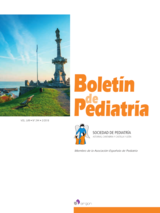Sepsis recurrentes. ¿Dónde se esconde el Streptococcus agalactiae?
S.I. Marín Urueña , M.E. Infante López , M.M. Montejo Vicente , C. Escribano García , C. Alcalde Martín , S. Caserío Carbonero
Bol. Pediatr. 2018; 58 (244): 125 - 128
Introducción. El Streptococcus agalactiae continúa siendo un importante responsable de sepsis neonatales y meningitis. A pesar de la profilaxis intraparto, la sepsis neonatal tardía se mantiene estable a lo largo del tiempo. Pacientes. Presentamos los casos de dos gemelas que ingresan a los 7 y 10 días de vida, por clínica compatible con sepsis neonatal tardía. La primera de ellas asocia meningitis. Tras curación completa después del tratamiento antibiótico indicado, la segunda gemela sufre una recurrencia asociada a endocarditis. Entre los cultivos recogidos y a pesar de ser una madre no-portadora, el Streptococcus agalactiae también se pudo aislar en la leche materna. Comentarios. En la profilaxis y manejo de estas infecciones influyen muchos factores. La aparición de la sepsis en ambas gemelas, la recurrencia sufrida por una de ellas y la aparición del Streptococcus agalactiae en la leche materna hacen plantearse qué implicación tienen las diferentes vías de transmisión. La retirada de la lactancia tras encontrar el germen en la leche materna no está justificada según la evidencia disponible, siendo necesarios estudios sistematizados que esclarezcan la prevalencia y la fisiopatología de esta vía de transmisión.
Recurring sepsis. Where is Streptococcus agalactiae hidden?
Introduction. Group B Streptococcus keeps on being responsible of an important amount of neonatal sepsis and meningitis. In spite of intrapartum antibiotic prophylaxis, late-onset disease rates remain unchanged.
Patients. We report on twins who both twice developed GBS late-onset sepsis at 7 and 10 days of life. First twin also suffered meningitis. After recovery, second twin had a recurrence associating endocarditis. Group B Streptococcus was isolated from breast milk samples, though their mother had no rectovaginal colonization (before and after delivery).
Conclusions. Different factors influence late-onset prophylaxis and treatment. Synchronicity of episodes in both twins, recurrence suffered in the second one and isolation of Group B Streptococcus in milk breast samples should make us think about the implication of different ways of trasmmision. There is no evidence on whether breast milk should be ceased when found to be Group B Streptococcus contaminated. Further investigations are needed to elucidate the prevalence and pathophysiology of this transmmision via.
Artículo completo (PDF) (165 kb.)
